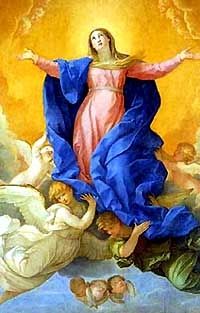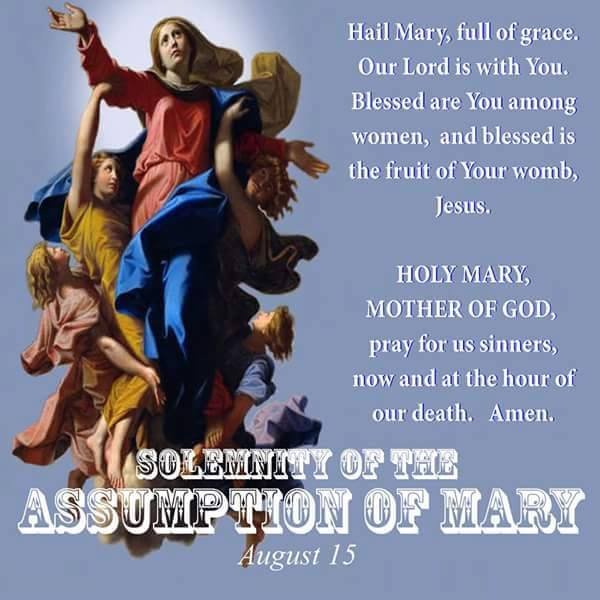The Assumption of the Blessed Virgin Mary
August 15
The Bible makes no mention of Mary's death. But there are also the apocryphal books. Catholics call these the "deutero-canonical books". There are many more details about the life of Mary than the New Testament contained in the Bible. Jewish rabbis compiled a list of the Holy Scriptures around the year 100. They saw only the scriptures on that list as divine. They were "canon" the guideline for faith.
The apostle John, when he entered the sanctuary at Ephesus, was addressed by the Holy Spirit, who informed him that Mary was dying and asked him to go to Bethlehem, where Mary lived. During Mary's last hours, many miracles occurred, according to the apostle John: the blind seeing, the deaf hearing, the lame walking, lepers cleansed, and those possessed by unclean spirits healed. Anyone who was afflicted with illness and weakness touched the outside wall of the house where Mary lay and cried out, “Holy Mary, who brought forth Christ our God, have mercy on us!” was immediately healed.
There are various stories about her subsequent life. According to (Roman Catholic) tradition, Mary must have died somewhere between 36 and 50 AD. B.C. died in Jerusalem or Ephesus (in the House of the Virgin Mary).
Mary was taken up into heaven, soul and body, as Mother of God's Son, who took on flesh in her sinless body. Because she did not know original sin, it was appropriate that Mary should not suffer the consequences of original sin, including the painful separation of soul and body at death and the subsequent dissolution of the body. Her physical body has not experienced decay, nor has the body of her divine Son. Upon her “falling asleep,” as the Eastern Church calls it, her physical body was instantly transformed into the glorified resurrection body, which has since been seen during her apparitions by so many seers, especially over the past 150 years.
Mary did not undergo physical death with all its suffering, but she did die under the cross in her heart with her Son, as co-redemptrix. Historical proof of the mystery of her ascension is the fact that there was never a grave in which her body would have been buried. The new Adam, Christ, and the new Eve, Mary, through their sacrifice to humanity, have given back the beauty and integrity of the body, which had to die and decompose as a result of the fall of the first Adam and Eve.
August 15 is still celebrated as the feast day "Mary's Assumption". Mary, like Christ, rose from the dead and was taken alive to Heaven, where she was crowned as Queen.
My note:
It is striking that in the writings of the New Testament (the 4 Gospels, the Acts of the Apostles, the Epistles of the Apostles, the Apocalypse) no mention is made of Mary's last years. Nor do we know where, when and in what circumstances the Blessed Virgin died, was buried and/or was taken up into heaven. The first chapter of the Acts of the Apostles (1:14) states that Mary joined the prayer of the apostles and was perhaps also present at the descent of the Holy Spirit on Pentecost. After that nothing more...
The mother of Jesus remained completely in the background in the early days of Christianity. From the 4th century onwards, all kinds of apocryphal writings arose, which, although the Church did not include them as authentic writings in the canon of the New Testament, nevertheless reflected what was in popular belief and in oral tradition. These oldest (preserved) apocryphal stories situated the death of Mary, among the apostles, on Mount Zion near Jerusalem. Only much later, in the 9th century, would the ancient city of Ephesus, located on the west coast of present-day Turkey, be identified as a possible place of Mary's death, especially within the Western Church.
What does the Assumption of Mary mean?
The Assumption of Mary is the Catholic solemnity of August 15 on which the Church commemorates the Virgin Mary's assumption into heaven by God. On the same day, the Orthodox Churches celebrate the Dormition of the Mother of God.
The Assumption of Mary was introduced into Byzantium by Emperor Mauritius at the end of the 6th century; later the Church of Rome under Pope Saint Sergius I (687-701) took over the festival. The festival was first called Dormitio Mariae, which means 'dormment of Mary'. This name refers to an ancient tradition that tells that Mary died on Mount Zion in Jerusalem among the Apostles.

O Divine Father, the Blessed Virgin was conceived pure in body in order to carry Your Son in her womb, and when her life on earth ended, You gave her a glorified body and raised her directly into Heaven. I ask her to pray for my attitudes regarding my physical health; may I appreciate the body You gave me while overcoming the passions of the flesh. Stop me from destroying this temple of the Holy Spirit through laziness, harmful habits, addictions, and impurities, so that at my death my own body will be better prepared to receive its Heavenly reward. Holy Mary, pray for me now and at the hour of my death.
Amen.
